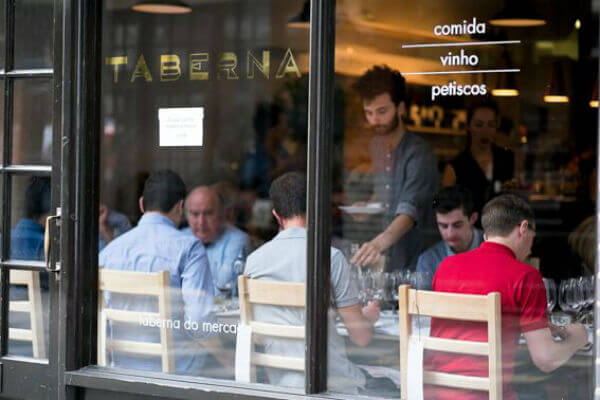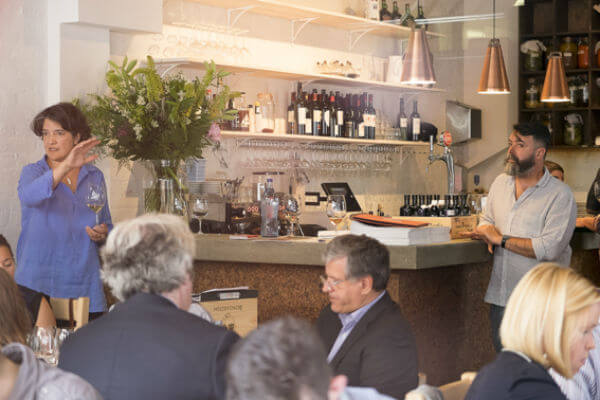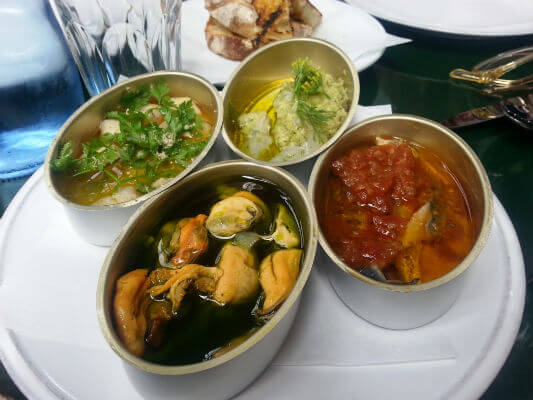Text Sarah Ahmed
It was a thrill to present a tasting on behalf of the Alentejo Wine Commission at one of London’s hottest new restaurants, Taberna do Mercado. And even more exciting that, not only is its chef/patron Portuguese, so is the food and wine. Which may sound a strange thing to say but, thus far, Nuno Mendes’ renown has rested on the eclectic, highly innovative dishes of his previous restaurant, Michelin-starred Viajante, now his American accented menu at celeb hang out Chiltern Firehouse (where he is Head Chef).

Nuno Mendes – Photo by Charmaine Grieger | All Rights Reserved
In an interview with Mendes a couple of years ago, he let slip about his plans to open “a very casual, fun, modern but rustic Portuguese restaurant in London.” But there was a problem. He explained, despite Portugal’s “wealth of amazing unique products,” it was hard to source them, Why? He said because, “production is very limited in quantity and second very few artisan producers see the potential outside the local market to expand their project.”
Fully expecting him to have overcome these challenges, I asked him what had changed since we last spoke. Mendes asked, “did I want the nice answer or the true answer?” Naturally, I said the truth! Admitting “it makes me sad,” Mendes remains palpably frustrated that, in the UK, sourcing the very best Portuguese products of which he can be “super-proud” has still proved elusive. He observed, UK-based Portuguese-owned importers are “mostly used to supplying the local ex-pat community” (as opposed to high-end restaurants with demanding ‘foodie’ customers). It reminds me of a point he made when we first met and emphasised how important it was in his field “to be aware of what’s happening in the food and wine world and to find a way to fit it in other people’s realities.” It’s why, he adds, “I had to walk away” from Portugal when he opened Viajante – the range of products did not fit with his Michelin-starred reality. It was “not amazing,” nor could he count on consistency of supply.

Taberna do Mercado – Photo by Charmaine Grieger | All Rights Reserved
The good news? Where he sees Taberna do Mercado as “the portal to tap into Portugal’s great resources,” he tells me “I’m not giving up.” He may be softly spoken and modest of demeanour, but there’s a steely determination in Mendes’ eyes when he reveals his solution. Pointing out “I have many more connections than the importers based here,” (not to mention a Michelin-starred chef’s fastidiousness about sourcing the very best), he plans to set up his own export/import business. After all, his reputation depends on it. And the stakes are high where, given supply issues, he believes it’s premature for Portuguese food to be touted as the next big thing as The Daily Telegraph recently suggested. It is why he asserts, “now is where the research comes in…we can’t relax, we have to push ourselves and bring in the best…we have to evolve”. There is no room for complacency.
Shortly after the tasting, I paused to reflect on Mendes’ comments in relation to Portuguese wine when a journalist asked me why it has yet to really hit the big time. I am pleased to report that the UK has been rather better served by its wine importers, especially Portuguese specialists Raymond Reynolds and Oakley Wine Agencies who have helped their producer clients navigate the highly competitive UK market with aplomb. But if, like Mendes, I am to be Portugal’s critical friend, the truth is that far too many Portuguese producers have yet to find a way to fit into the realities of the UK market, which is widely acknowledged as the most competitive in the world. What’s more, ‘cellar palate’ (becoming too habituated to your own wines, including flaws) can be a problem. It’s why the most successful Portuguese winemakers themselves keep visiting the UK to understand where their wines best fit (and to benchmark them against the competition). It also helps to ensure that they are still seen and heard in our crowded, noisy marketplace.
Happily, all eight producers whose wines I showed in my master-classes at Taberna do Mercado are represented in the UK. But there is still work to be done where Alentejo has forged it reputation in the UK on a bedrock of great value, fruity, approachable reds. The next step is to raise the profile and appreciation of its premium, terroir-driven red and white wines among fine wine lovers (white wines now represent around 20% of wines from Alentejo). It was a challenge to which I gladly rose.

Me and Nuno Mendes talk Alentejo wine & food – Photo by Charmaine Grieger | All Rights Reserved
My selection of wines was accompanied by Mendes’ contemporary take on petiscos (how’s that for fitting them into the realities of the UK market) and followed by an excellent tasting of Alentejo olive oils presented by Teresa Zacarias of Casa do Azeite. Here are my notes on the wines, together with some background on what individuates this diverse selection in terms of terroir and winemaking. As you’ll see, the Alentejo is not as flat or unremittingly hot as regional stereo-types would have you believe. What’s more, all the grapes were hand-picked.
Herdade do Rocim Olho de Mocho Reserva Branco 2013 (VR Alentejano)
Terroir: this single varietal Antão Vaz comes from Vidigueira, one of Alentejo’s eight DOC sub-regions. Despite being the southernmost, it has a long tradition of producing white wines. Why? It’s all to do with the lie of the land, specifically, the Vidigueira fault, a 50km west-facing escarpment known as the Serra do Mendro which marks the border between the Upper and Lower Alentejo. Rising to 420m it traps cool and humid Atlantic winds which cool the region with overnight fogs. Cold air also descends from the Serra do Mendro at night. What’s more, when southern winds bring clouds, the escarpment causes a cloudburst (rainfall). For winemaker Catarina Vieira, this is what accounts for Vidigueira’s “very mineral, elegant and fresh wines that can age very well.” She believes that the sandy soils also enhance the minerality of her Antão Vaz, which is sourced from her best, dry grown, low cropping 24 year old vines.
Winemaking: Hand-picked early (on 3rd & 4th September) to preserve freshness (no acidification is required), the wine fermented in new 300 litre French oak barrels for around 20 days. It was then taken off lees and aged in barrel for five months. Meanwhile, the fine lees were aged for two months in second use barrels with daily batonnage for a month or so, then added back to the wine. For Vieira, this work with the fine lees is very important for the minerality, freshness and for the aging potential of this wine.”
Tasting note: thanks to the work with the lees it exhibits struck match/flinty notes to nose and lemony palate, with hints of green olive, under-ripe pineapple and dried pear as it opens up. A long, firm, mineral finish with racy, grapefruity acidity sustained my sample bottle of this wine well into day three. 13.5%

House-canned fish Nuno Mendes style – Photo by Sarah Ahmed | All Rights Reserved
Cartuxa Pêra Manca Branco 2012 (DOC Alentejo)
Terroir: this blend of 62% Antão Vaz and 38% Arinto comes from Évora, another DOC sub-region, this time in the Alto/upper Alentejo. The fruit was sourced from three parcels of Cartuxa’s oldest vineyards on slopes which rise to 300 metres above sea level. Planted in 1980 on brown granitic soils, the vines were dry grown.
Winemaking: for this fuller-bodied, more traditionally-styled white, the fruit was hand-picked later and in three stages for complexity (12, 18 & 19 September). Following de-stemming and crushing, a portion of the grapes was left in contact with the skins prior to fermentation. Sixty-seven percent of the wine was fermented and aged on the lees for 12 months in French oak barrels (60% new) with batonnage for body, complexity and ageing potential. The balance was aged in stainless steel (to enhance fruitiness) with lots of batonnage (for body). There was no acidification.
Tasting note: a rich, beeswaxy nose with stone fruits, especially apricot close to the kernel, which notes follow through on a palate with a pronounced nuttiness (fresh marzipan/calisson) and vanillin oak. Though weighty, a ripe but zesty backbone of citrus acidity brings balance and teases out a long, leesy, savoury finish with lemon and orange peel nuances. A powerful wine, which often puts me in mind of an Hermitage from the Northern Rhône, France. 13.5%
Monte da Ravasqueira MR Premium Rosé 2013(VR Alentejano)
Terroir: this rosé made from 100% Touriga Nacional is from Arraiolos in the Évora district of Alto Alentejo. For winemaker Pedro Pereira, the key to the freshness of Monte da Ravasqueira’s range lies in the estate’s very pronounced diurnal temperature variation. Even in the hottest months of July and August when temperatures might hit 40 degrees centigrade, at night the temperature can fall below 10 degrees. Cool nights help the grapes to retain acidity better; it’s good for aromatics and structure too. Gonçalves attributes this strong diurnal to the amphitheatre-like topography of the vineyard (all 45 hectares are planted on slopes rising to 270m), together with the surrounding forest and dams. Though supplemental irrigation is required, clay-limestone soils have good moisture retention while granite outcrops seem to enhance minerality/freshness, as in the Dão.
Winemaking: where Gonçalves’ style revolves around “freshness + complexity (a matrix of flavours) + varietal character + intensity + concentration,” he sourced fruit from five different parcels (by row orientation-exposure, soil type and canopy management) and hand-harvested the grapes on different days, ranging from 8 September to 27 September. The grapes were kept in refrigerated containers between two to 20 days at two degrees for concentration and to enhance aromatic potential and fruit. Two parcels were pressed directly to new French oak barrels and naturally fermented with batonnage on full solids. The other three were first settled and inoculated with yeast prior to transfer to new French oak barrels on the second day of fermentation. All five parcels were aged in barrel on the lees for six months with light batonnage for the first 2 months.
Tasting note: Touriga Nacional seems to lend itself well to rosé wines and this is an unusual example, savoury yet fruity, round, yet fresh. It’s thoroughly delicious with savoury, creamy lees, delicate wild strawberries, strawberry shortbread and refreshing peach tea. Mineral acidity brings freshness and persistence to its lingering finish. 13%
Susana Esteban Aventura Tinto 2013 (VR Alentejano)
Terroir: this, my first red, is from the Alto/Upper Alentejo but is a blend of DOC sub-regions. Esteban sources the Aragonês and Touriga Nacional (40% and 20% of the blend respectively) from a dry grown 15 year old vineyard in Évora at 300m on clay/limestone soils. The balance is a mix of varieties from a dry grown 30 year old field blend vineyard in Portalegre, the Alto Alentejo’s northernmost sub-region. It’s not just the northerly location which accounts for Portalegre being Alentejo’s coolest, wettest area. The Serra de São Mamede mountain – at over 1000m, the highest point in southern Portugal – provides serious elevation (up to 800m) and poor granitic soils. Where Esteban’s aim is “to make a fresh wine, with character but appealing at the same time,” she looks to Portalegre for freshness and austerity, while Évora provides the heat which the winemaker believes Touriga Nacional and Aragones need to show their potential (though she emphasises “I have attention to pick with only 13 or 13% alcohol).
Winemaking: the grapes are hand-picked and naturally fermented (with no acidification) in small stainless steel temperature controlled lagares. I very much like the fact that Esteban has put the emphasis squarely on the fruit and freshness – this wine is unoaked.
Tasting note: wonderful vibrancy and texture (think crushed velvet) to its pure, freshly picked and puréed (so it feels) fruits of the forest. Smooth tannins and sappy acidity reinforce the charming immediacy of this youthful red. Lovely. 13.5%

Casa do Porco Preto, Alentejo at Taberna do Mercado – Photo by Charmaine Grieger | All Rights Reserved
Herdade de São Miguel Reserva 2012 (VR Alentejano)
Terroir: Herdade de São Miguel is located in the Redondo sub-region (a DOC) of the Alto/Upper Alentejo. For Alexandre Relvas junior the Serra d’Ossa hills (which rise to 650 metres) shelter Redondo’s vineyards from northerly and easterly winds and furnish cold, dry winters to offset the hot, sun-drenched summers. His vineyard is located at 400m on low yielding clay/schist soils which produce concentrated, small berries. This wine is a blend of 80% Alicante Bouschet, 15% Aragonez and 5% Cabernet Sauvignon from 13 year old vines.
Winemaking: hand harvested fruit is totally de-stemmed and undergoes a 48 hour cold soak prior to fermentation in open stainless steel lagares with automatic pigeurs for softer extraction, a bit of natural oxidation too “to help fix colour and tannins from the beginning” says Relvas. It was aged for 12 months in 400 litre French oak barrels (50% new).
Tasting note: an intense nose of blackcurrant and bramble fruit with a touch of vanillin oak and dusty schist undertones, which follow through on a succulent palate with lovely freshness. Though only five percent of the blend, the Cabernet is quite evident in flavour profile (blackcurrant with a hint of mint) and fine, gravelly, mineral tannins. It does not have the concentration or complexity of the (more expensive) wines which followed, but it’s well balanced and persistent. Very well made, indeed wears its 15% abv lightly.
Quinta do Mouro Touriga Nacional 2010 (VR Alentejano)
Terroir: This single varietal Touriga Nacional is from Estremoz in the Borba sub-region (a DOC) of the Alto/Upper Alentejo. It is north of Redondo and just north of the Serra d’Ossa, which offers a little protection from the warm south winds. Where Quinta do Mouro is at 420m, elevation also tempers the climate, as do plunging night-time temperatures which, says winemaker Luis Louro, can be 20 degrees lower than in the day “especially at the later stages of maturation, and fogs are common.” Schist soils and dry-farmed vineyards also account for the very structured, ageworthy and characterful style of Mouro’s reds. Sourced from “a very good” Douro vineyard in 1998, the Touriga Nacional was grafted onto Castelão vines which had been planted in 1989.
Winemaking: hand-harvested fruit was partially de-stemmed, leaving around 10% whole bunch for a bit more structure and fresher flavours. The grapes were foot-trodden in lagares and underwent a two day cold soak prior to starting fermentation. It finished fermenting in stainless steel tanks with temperature control and, after pressing, was aged for 12 months in new 300 litre French oak barrels.
Tasting note: a deep, opaque plum hue with an exotic bergamot perfume which provides lift to a concentrated raspberry and plum, vanillin-edged palate together with lively peppery whole bunch notes, dried sage and mint. Textured suede-like tannins cleave the flavours to the palate, amplifying its intensity and back palate resonance. Powerful, a little wild even, yet balanced. A charismatic single varietal Touriga. 14%
João Portugal Ramos Marquês de Borba Reserva 2012 (DOC Alentejo)
Terroir: also from Estremoz, this blend of 30% Trincadeira, 30% Aragones, 25% Alicante Bouschet and 15% Cabernet Sauvignon comes from João Portugal Ramos’ original vineyard. The vines, planted in 1989, are located around his house and have been the source of this wine since it was first made in 1997. Located at 350m on very old schist
Winemaking: hand harvested grapes are picking grapes at night and early in the morning. The grapes are partially de-stemmed (50% whole bunch) and start co-fermenting (naturally) in marble lagares with foot treading. For Ramos the advantages of the lagares include a higher area of contact between the liquid and the solid part of the must, gentle homogenisation of the must (because a thinner cap is formed compared to the normal tanks) and the aesthetics of the local marble (which, incidentally Mendes has used for his table tops at Taberna do Mercado). The final third of the fermentation is completed in stainless steel vats with the benefit of temperature control. The post-ferment maceration usually lasts about two weeks. The wine is then matured for 18 months in French 225 litre oak barrels (two thirds of which are new).
Tasting note: a very polished red with tobacco and cigar box to nose and palate. Red fruits dominate the attack while the Cabernet becomes more assertive going through, bringing well-defined blackcurrant fruit and a spray coating of fine but plentiful powdery tannins which build in the mouth. Dry, firm, focused and very fine with excellent balancing freshness. The tightest of the reds, it has great ageing potential. 14.5%
Herdade do Mouchão 2010 (VR Alentejano)
Terroir: this blend of around 70% Alicante Bouschet and 30% Trincadeira comes from one of the region’s most established players, Herdade do Mouchão, which has belonged to the same family since 1874. Mouchão was the first vineyard to be planted to Alicante Bouschet and the current vines trace their genetic origin back to this original 19th century stock. Mouchão is in Sousel to the north of Borba in the Alto/Upper Alentejo. The Alicante Bouschet is sourced from several parcels near the winery at around 230m and ranging between 10 and 30 years old. Located on a delta between two small rivers, the sandy topsoil is well-drained but the deep clay beneath retains the humidity which allows for a balanced maturation, freshness and good acidity. The hallmarks of Mouchão’s great ageing potential. The thinner skinned Trincadeira benefits from being planted on higher, well-drained ground at around 400m.
Winemaking: this most traditional of wines is hand picked and fermented in the old winery’s original stone lagares with 100% stems. It is then aged in large old 5,000 litre toneis for two to three years. It spends a further two to three years in bottle before being released.
Tasting note: a very deep hue with a rich, very complex nose and palate – almost a meal in itself – but a balanced one. Mouchão 2010 has savoury layers of mellow dried fig, black olive and incipient leather with inky floral, tobacco, berber whisky (stewed mint tea) and eucalyptus top notes. Sturdy, spicy, grape-driven tannins build in the mouth, yet are very well integrated – not in the least aggressive. A very long, involving finish has this estate’s warm earth, slightly bloody, ironstone tang. Terrific sense of place. 14%




Matthew
I love wines portugal
visit http://www.prestigewinesportugal.com
Matthew